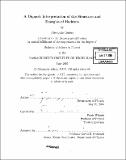A diquark interpretation of the structure and energies of hadrons
Author(s)
Selem, Alexander
DownloadFull printable version (3.160Mb)
Other Contributors
Massachusetts Institute of Technology. Dept. of Physics.
Advisor
Frank Wilczek.
Terms of use
Metadata
Show full item recordAbstract
I present a simple phenomenological model which successfully organizes and classifies essentially all hadrons. The model is originally inspired from three simple theoretical indications including: treating baryons as a two body system with a diquark and quark connected by a flux tube, thereby indicating that they lie on Regge trajectories; allowing for independent combinations of diquark and quark to enumerate the observed trajectories; and that spin-flavor symmetric diquarks are more massive than their stisymmetric counterparts. With this framework essentially all hadrons can be consistently organized confirming the first three hypotheses and elucidating new ones, including: a universal slope or flux tube tension for both baryons and mesons implying the same color-charge at the flux tube ends, small spin forces external to diquarks, and the existence of tunneling effects. This framework and classification can then be used to estimate diquarks masses, and can be applied to exotic and cryptoexotic states. The model also make predictions for the existence of several particles and their energies; among them, tetraquark states. Finally, the arguments presented here naturally lead to many future projects in both experiment and theory.
Description
Thesis (S.B.)--Massachusetts Institute of Technology, Dept. of Physics, 2005. Includes bibliographical references (leaves 67-70).
Date issued
2005Department
Massachusetts Institute of Technology. Department of PhysicsPublisher
Massachusetts Institute of Technology
Keywords
Physics.